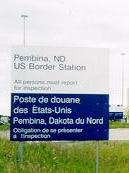KPH not MPH
While in Canada pay attention to that "other scale" on your speedometer--everything is in KPH (the highway patrol has heard that one before). The rough equivalent is 100 KPH = 60 MPH. In practical terms, Canadian speed limits are similar to the US (unless you're from Montana).
Gas Prices "Buy the Liter"
Try to fill up on the US side before crossing. The gas prices are very high and prices are quoted by the liter. Remember there are 3.785 liters per gallon. So multiplying by 4, then taking a little less than 2/3 of that is the price per gallon (or whatever the exchange rate; 2/3 being the often CAD$1.50 = USD$1.00).
For example: C$0.79/liter = C$3.00/gallon (approx.) = US$2.00/gallon (approx.)
Roads

Bilingual Sign entering U.S.
(Pembina Crossing)
You may notice subtler differences as it comes to spending money on roads. There isn't much for shoulders, road markers or most signs (--except to tell you all of the agencies overseeing the construction, in two languages). There are nearly no overpasses on any roads in this part of Canada (something you rediscover just south of Pembina on I-29).
Canadians didn't choose to bulldoze down strips of city blocks (and split neighborhoods) for cars.This means there are no "fast arteries" in and out of the cities. Make sure to allow time to accomodate traffic lights on your way in town.
The lack of overpasses lead to explicit pedestrian crossings if there is a long stretch between traffic lights. If you see the flashing yellow lights next to the "pedestrian" signs over the street --STOP! Pedestrians have the right of way.
Bilingualism
You quickly get used to the dual language signs. In the central part of Canada you'll not have to have a translator (even in St. Boniface). Though it helps to know that a "dual carriageway" is the queen's English for what Americans know as an 4-lane highway.
The nuances of French allow many signs to be correct for both languages using the following convention. French adjectives often follow the noun such as "Rue Taché." English puts them before the noun: "Taché Street." So a bilingual street sign would be "Rue Taché Street" with "Rue" and "Street" in somewhat smaller type.
In Quebec, you may be happy that there's English anywhere.
Food Differences: "Bye Bye Mr. Salty"
Though all the same restaurants are there with the same foods Americans know and love, there are a few differences (each has a little maple leaf, A&W's have a very different color schemes for example). The most significant is to protect your heart: Most everything is Salt Free! This does take getting use to, no salt on popcorn, nor on peanuts, nor on sunflower seeds (unless "flavored"), nor on french fries at McDonalds. If you want salt you'll have to take your own to the park or pick it up at the restaurant. On the other hand, you may want try some vinegar on your fries (it come in packets along with ketchup at Mickey D's -- I love it!).
If you go shopping you run into Beer and Muffin shops (separate, not combined). If you go to the grocery store check out all the flavors of potato chips --Ketchup anyone?
Alberta Exceptions
If you're going to Edmonton or Calgary some of the above is much less common. Unlike Winnipeg, street signs are not bilingual, salt is somewhat more common on foods. The fact is Alberta feels a lot like Texas in many ways thanks to its oil and cattle heritage.